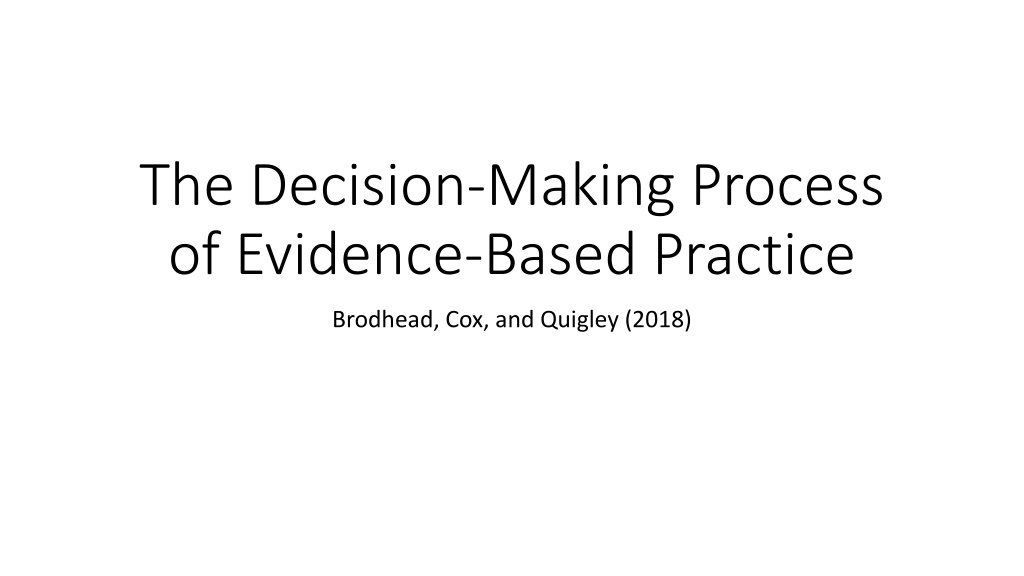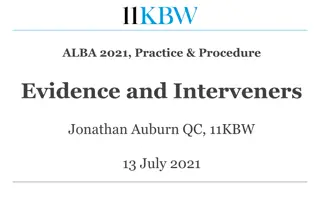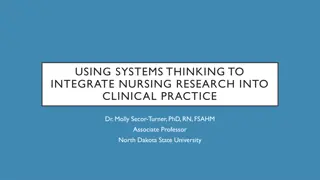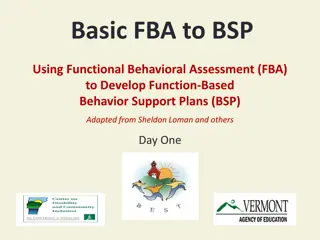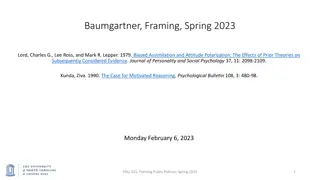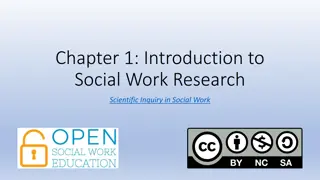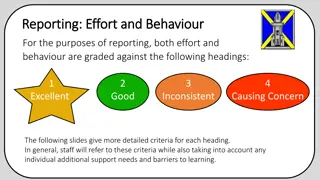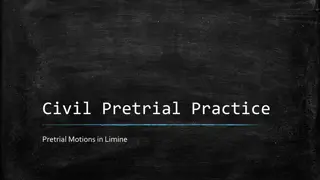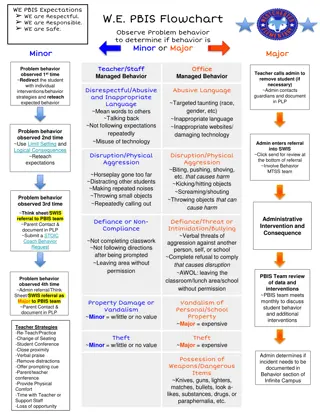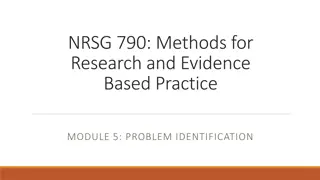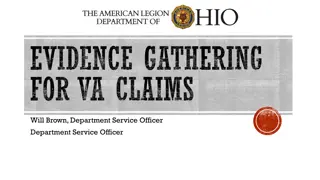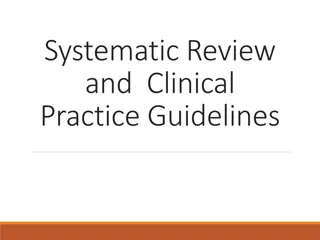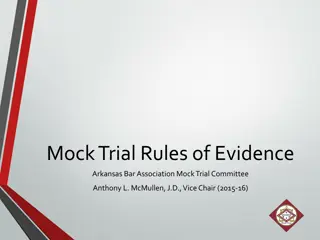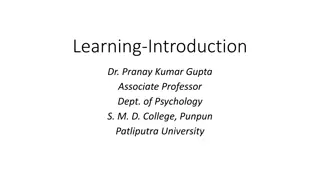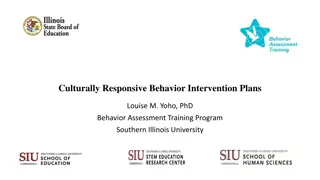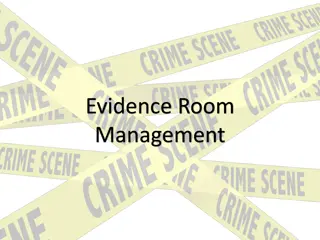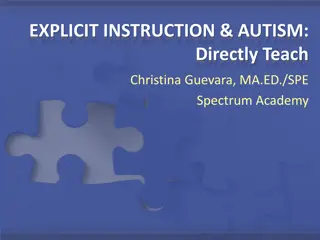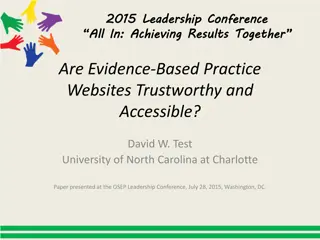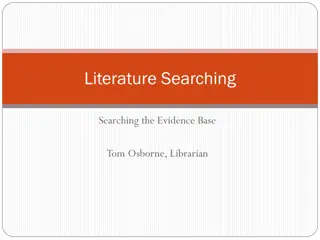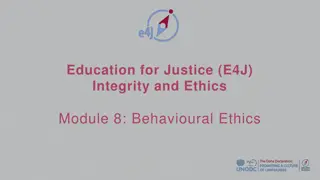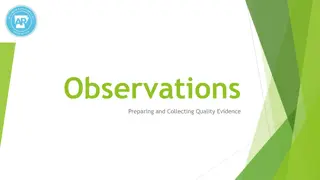Understanding Evidence-Based Practice in Behavior Analysis
Definitions and analogies from the field of medicine help clarify the concept of Evidence-Based Practice (EBP) in Behavior Analysis. EBP involves integrating current best evidence with clinical expertise and client values to make informed decisions. The three-legged stool analogy illustrates the importance of balancing research evidence, professional expertise, and client characteristics in EBP. Case studies highlight the practical application of EBP in Behavior Analysis.
Download Presentation

Please find below an Image/Link to download the presentation.
The content on the website is provided AS IS for your information and personal use only. It may not be sold, licensed, or shared on other websites without obtaining consent from the author. Download presentation by click this link. If you encounter any issues during the download, it is possible that the publisher has removed the file from their server.
E N D
Presentation Transcript
The Decision-Making Process of Evidence-Based Practice Brodhead, Cox, and Quigley (2018)
Chapter Overview Definitions from Medicine The three-legged stool analogy Defining evidence-based practice in ABA Using evidence-based practice in ABA Case studies in EBP in ABA
Definitions from Medicine Evidence-based practice (EBP) is a term utilized in many different contexts There is disagreement within behavior analysis and other disciplines regarding the definition of EBP Wilczynski (2017) provides a book length analysis of this topic
Definitions from Medicine Medicine Sacket et al., (1996) Conscientious, explicit, judicious use of current best evidence in making decisions about the care of the individual Behaviors related conscientious, explicit, and judicious use of evidence might interfere with balancing client values and professional values
Definitions from Medicine Medicine Strauss, et al., (2011) Integration of the best research evidence with our clinical expertise and our patient s unique value and circumstances Emphasizes a process to integrate research evidence, professional expertise, and client characteristics
The Three-Legged Stool Analogy Evidence-based practice
The Three-Legged Stool Analogy Evidence-based practice
The Three-Legged Stool Analogy Evidence-based practice Clinical expertise
The Three-Legged Stool Analogy Evidence-based practice Clinical expertise
The Three-Legged Stool Analogy Clinical expertise
Defining EBP in ABA Smith (2013) an evidence-based practice is a service that helps to solve a consumer s problem. Thus, it is likely to be an integrated package of procedures, operationalized in a manual, and validated in studies of socially meaningful outcomes, usually with group designs (page 27). PECS and UCLA model are examples of manualized programs, but they do not have the level of evidence (i.e., group design research with socially meaningful outcomes) suggested by Smith as needed to be considered evidence-based practice
Defining EBP in ABA Slocum et al., (2014; also see Wilczynski, 2017) Critiqued Smith (2013) as an incomplete definition of EBP Suggested Smith s definition aligned with definitions of evidence supported treatments An intervention that has been shown through research to be effective with a given population (APA PresidentialTask Force, 2006)
Defining EBP in ABA Slocum et al., (2014; also see Wilczynski, 2017) Evidence-based practice of applied behavior analysis is a decision-making process that integrates (a) the best available evidence with (b) clinical expertise and (c) client values and context This definition aligns with medicine and psychology This definition highlights the importance of EBP as a process
Using EBP in ABA Identifying the best available evidence How do you find evidence-supported treatments? Search for strategies based upon the identified clinical presentation (e.g., pica, self- injury) This search strategy helps identify strategies specific to the problem at hand
Using EBP in ABA Identifying the best available evidence How do you maintain regular contact with the research literature? Creating opportunities to read research literature can reduce the need to search for strategies when faced with novel clinical presentations Subscribe to journals, regularly visit the websites of journals, subscribe to receive journal publication alerts, or create and attend journal reading groups with professional organizations
Using EBP in ABA Identifying the best available evidence How do can organizations support the process of evidence identification? Might purchase organizational access to journals or literature databases Provide opportunities for clinical reviews Provide opportunities for professional development (e.g., journal reading group, conference attendance, workshop) Organizational systems can be evaluated to determine effect upon employee identification of evidence
Using EBP in ABA Evaluating the available evidence once located Not all evidence is equal Researcher a search of the evidence may fail to yield relevant results, or only identify weak results. The practitioner might need to function as a researcher to identify a strategy that best solves the clinical problem at hand. Follow the core dimensions of ABA (Baer, Wolf, & Risley, 1968)
Using EBP in ABA Evaluating the available evidence once located Not all evidence is equal Synthesizer literature searches often yield multiple strategies of varying quality. Synthesizing the information is necessary. Use personal guidelines to synthesize (e.g., Quigley, Peterson, Frieder, & Peck, 2017) Use published guidelines to synthesize (e.g., National Autism Center, 2009, 2015)
Using EBP in ABA Evaluating the available evidence once located Not all evidence is equal User Sometimes the identified literature aligns closely with the clinical presentation. The practitioner can function as a user. That is, implement the strategy in a manner parallel to the publication
Using EBP in ABA Integrating evidence with client considerations Consider and discuss cultural variables with families There is sparse behavior analytic literature regarding how cultural variables (e.g., language, religion) impact treatment. Nevertheless, awareness and incorporation of cultural variables seems likely to improve intervention outcomes
Using EBP in ABA Integrating evidence with client considerations Verbally describe different options and possible outcomes and allow the family to choose Utilize procedures that do not rely on vocal verbal behavior (Hanley et al., 2005) Assessment of strengths and weaknesses can increase client considerations
Using EBP in ABA Integrating evidence with professional expertise Practitioners must practice within their scope of practice and competence One s competence within a defined scope of practice is different from other practitioner s competence within the same defined scope of practice Practitioners must determine if the clinical presentation is within their scope of competence
Case Studies of Evidence-Based Practice in ABA
Case Studies of EBP in ABA Briar The practitioner, Cedar, failed to follow an EBP process Cedar identified an evidence-supported treatment through a brief literature review. He did not incorporate client characteristics. Cedar lacked experience in supporting an individual with this clinical presentation
Case Studies of EBP in ABA Andrew Christine, the practitioner, identified a strategy from a review already conducted. She did not consider the client preferences for visual technology, nor the teacher s skill set for implementing the strategy.
Case Studies of EBP in ABA Vocational training Marissa designed a strategy based upon a synthesis of existing literature. The program was informed by client preferences and values. She monitored the effects of the strategy to better incorporate client preferences and values. Marissa also had experience developing and implementing strategies with the population.
